Abstract
To determine if a relationship exists among the magnitude and rate of airway rewarming, and the severity of bronchial obstruction in thermally induced asthma, we had seven subjects perform three- to four-point stimulus response curves with isocapnic hyperventilation of frigid air with and without pretreatment with inhaled norepinephrine. The latter was employed to alter the heat supplied to the airway walls by producing vasoconstriction. 1-s forced expiratory volume (FEV1) was measured before and 5 min after the cessation of each bout of hyperpnea and before and after norepinephrine. On a separate day, the subjects repeated the above challenges while the temperatures of the airstream in the intrathoracic airways were measured. Prenorepinephrine, FEV1 progressively decreased in a stimulus response fashion as ventilation rose, while norepinephrine shifted this curve to the right. As the level of ventilation increased, the size of the temperature difference between the cooling of hyperpnea and the rewarming of recovery followed suit, and their magnitude was linearly related to the severity of bronchial narrowing. Reducing the mucosal blood supply of the airways with norepinephrine limited rewarming and attenuated the obstructive response. These data demonstrate that the airway narrowing that develops following hyperpnea and the magnitude of the thermal differences are related, and that alterations in blood supply directly affect bronchial heat flux and influence obstruction.
Full text
PDF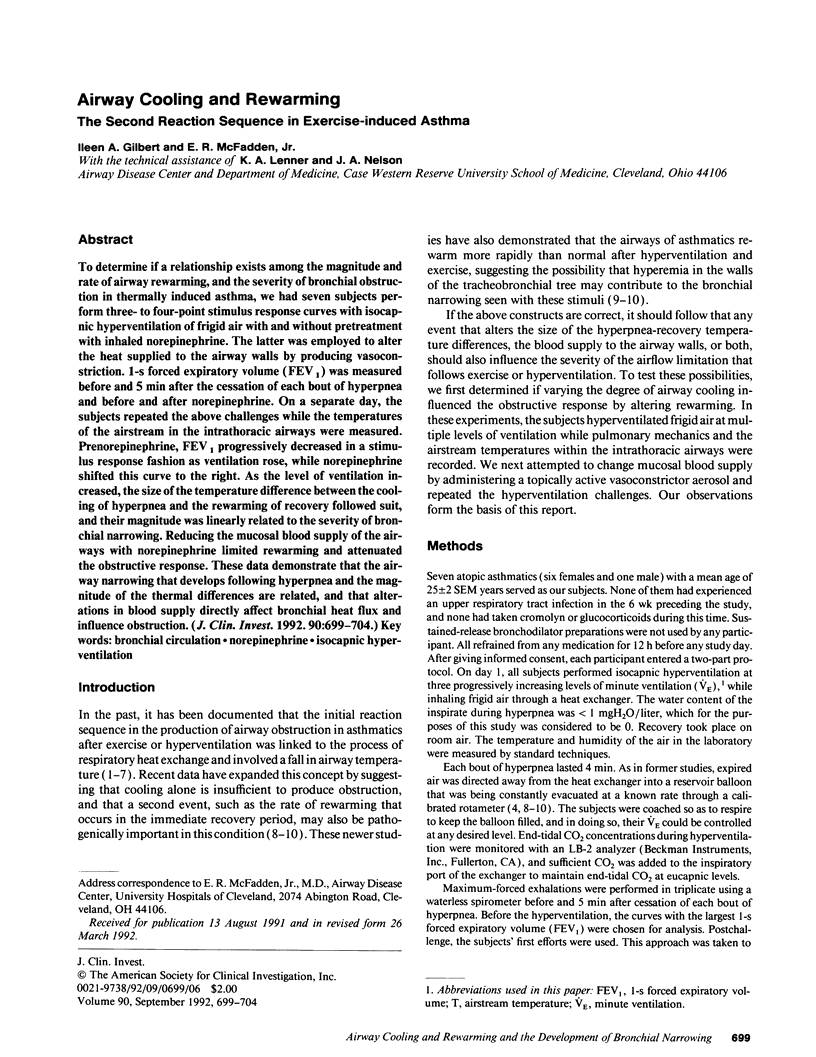
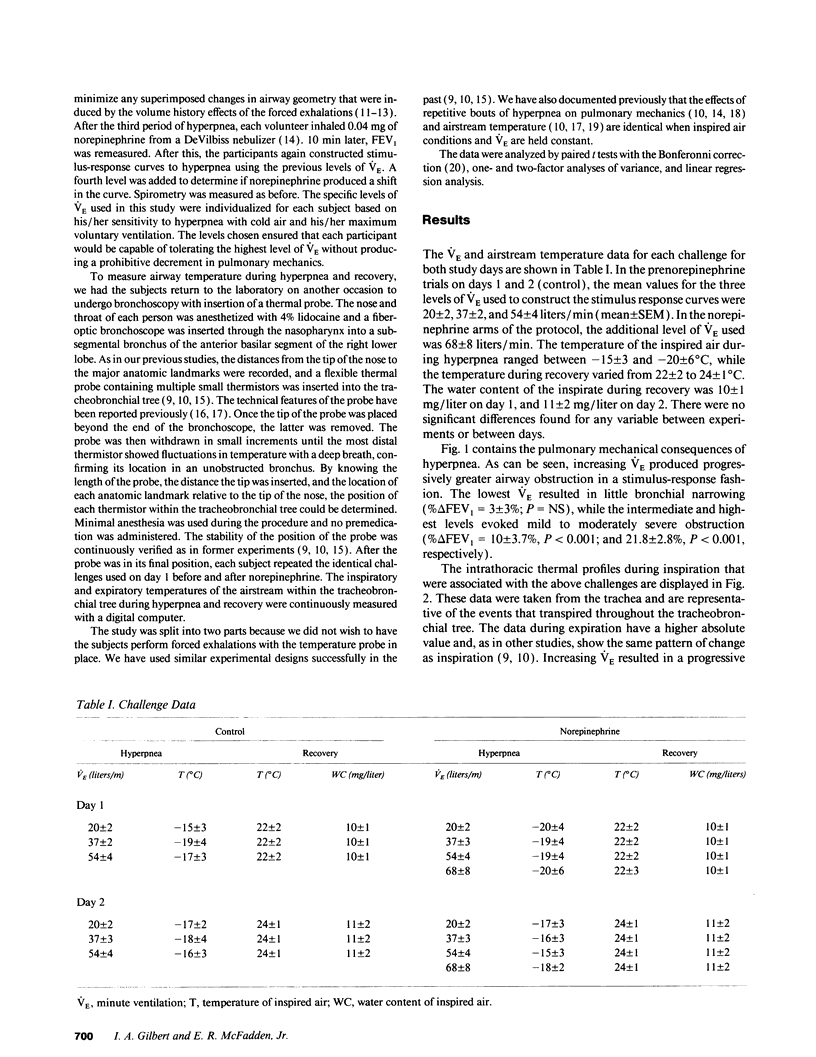
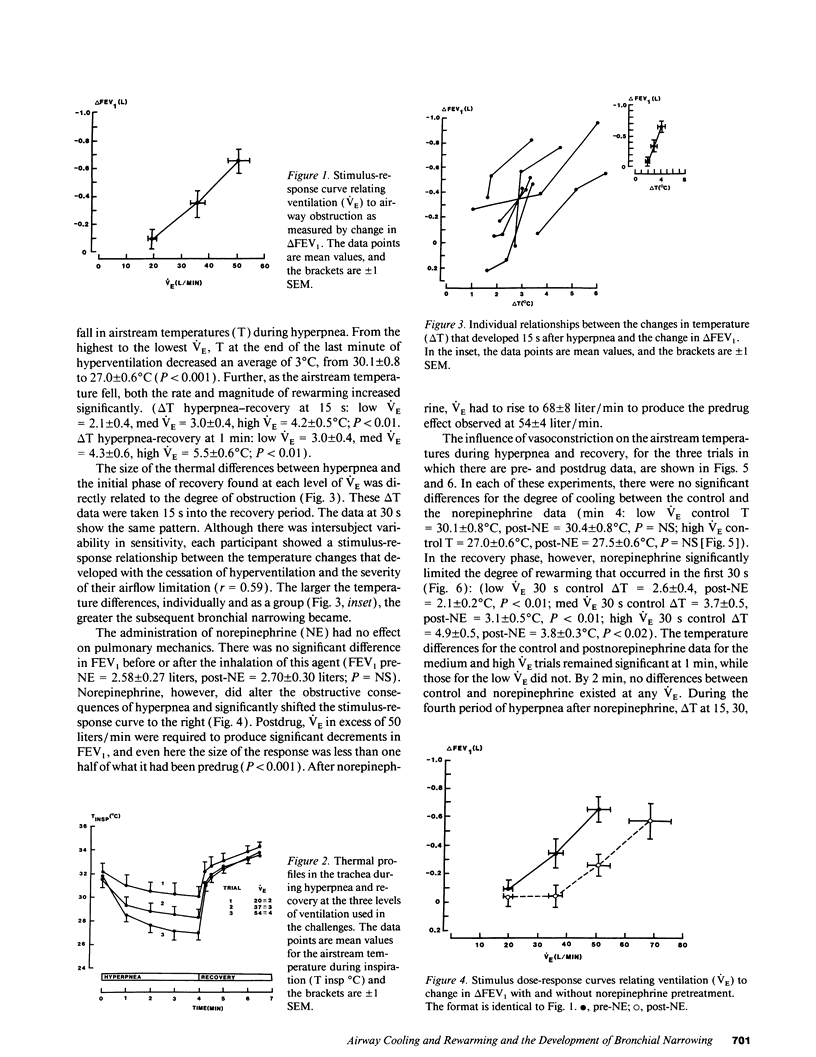
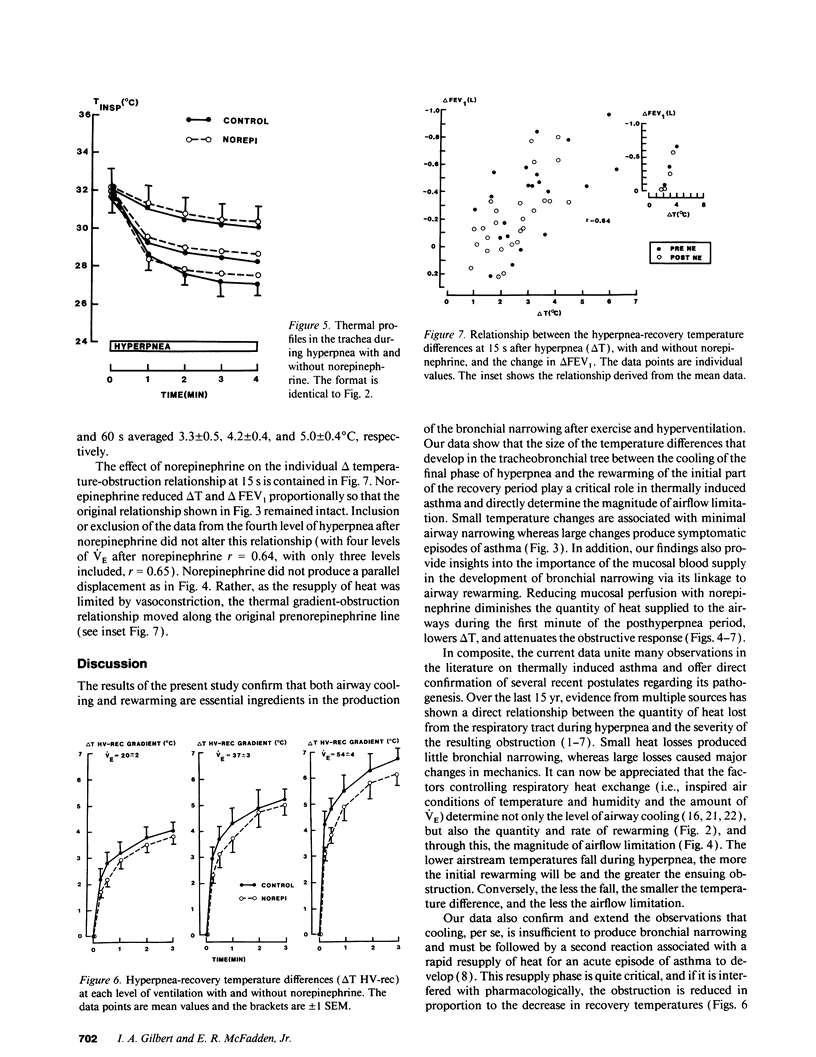
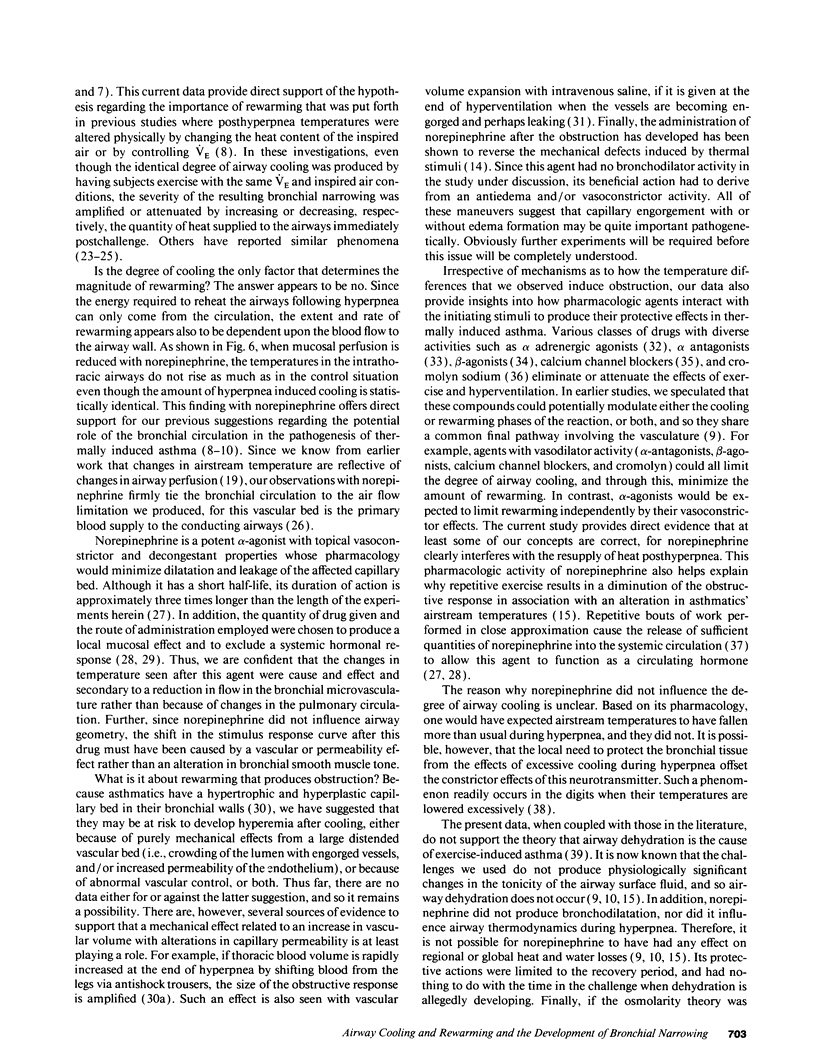
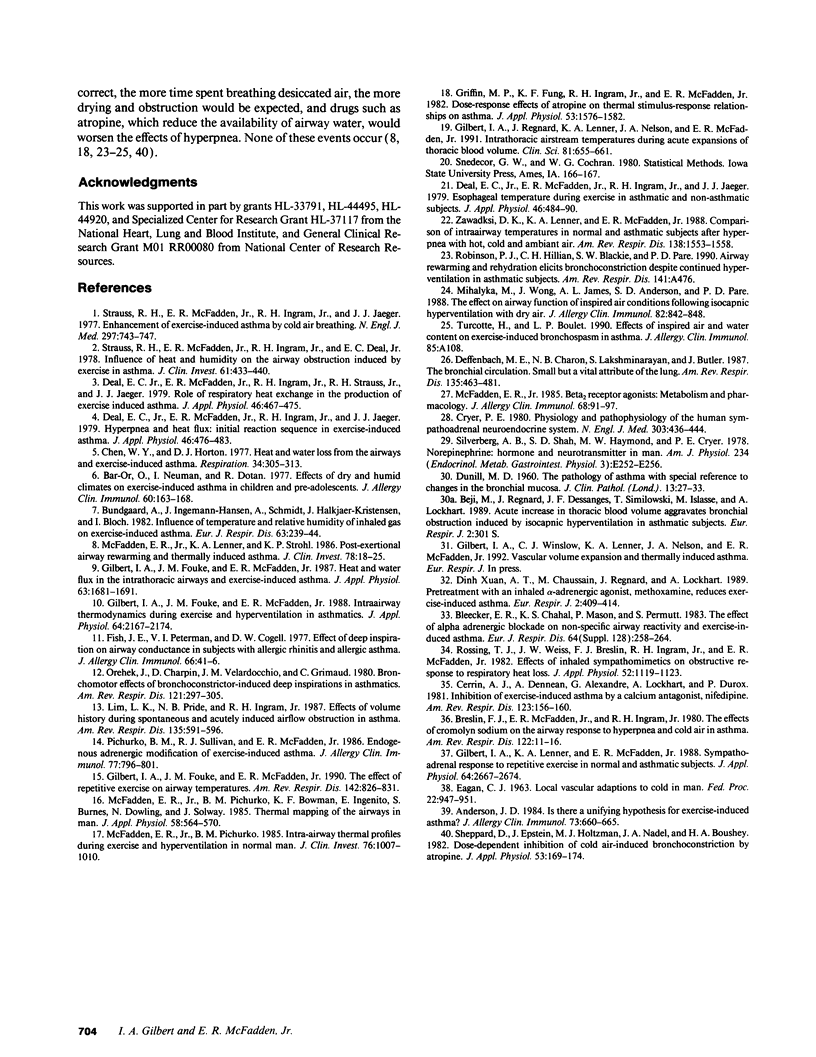
Selected References
These references are in PubMed. This may not be the complete list of references from this article.
- Anderson S. D. Is there a unifying hypothesis for exercise-induced asthma? J Allergy Clin Immunol. 1984 May;73(5 Pt 2):660–665. doi: 10.1016/0091-6749(84)90301-4. [DOI] [PubMed] [Google Scholar]
- Bar-Or O., Neuman I., Dotan R. Effects of dry and humid climates on exercise-induced asthma in children and preadolescents. J Allergy Clin Immunol. 1977 Sep;60(3):163–168. doi: 10.1016/0091-6749(77)90119-1. [DOI] [PubMed] [Google Scholar]
- Bleecker E. R., Chahal K. S., Mason P., Permutt S. The effect of alpha adrenergic blockade on non-specific airways reactivity and exercise induced asthma. Eur J Respir Dis Suppl. 1983;128(Pt 1):258–265. [PubMed] [Google Scholar]
- Breslin F. J., McFadden E. R., Jr, Ingram R. H., Jr The effects of cromolyn sodium on the airway response to hyperpnea and cold air in asthma. Am Rev Respir Dis. 1980 Jul;122(1):11–16. doi: 10.1164/arrd.1980.122.1.11. [DOI] [PubMed] [Google Scholar]
- Bundgaard A., Ingemann-Hansen T., Schmidt A., Halkjaer-Kristensen J. Influence of temperature and relative humidity of inhaled gas on exercise-induced asthma. Eur J Respir Dis. 1982 May;63(3):239–244. [PubMed] [Google Scholar]
- Cerrina J., Denjean A., Alexandre G., Lockhart A., Duroux P. Inhibition of exercise-induced asthma by a calcium antagonist, nifedipine. Am Rev Respir Dis. 1981 Feb;123(2):156–160. doi: 10.1164/arrd.1981.123.2.156. [DOI] [PubMed] [Google Scholar]
- Chen W. Y., Horton D. J. Heat and water loss from the airways and exercise-induced asthma. Respiration. 1977;34(6):305–313. doi: 10.1159/000193842. [DOI] [PubMed] [Google Scholar]
- Cryer P. E. Physiology and pathophysiology of the human sympathoadrenal neuroendocrine system. N Engl J Med. 1980 Aug 21;303(8):436–444. doi: 10.1056/NEJM198008213030806. [DOI] [PubMed] [Google Scholar]
- Deal E. C., Jr, McFadden E. R., Jr, Ingram R. H., Jr, Jaeger J. J. Esophageal temperature during exercise in asthmatic and nonasthmatic subjects. J Appl Physiol Respir Environ Exerc Physiol. 1979 Mar;46(3):484–490. doi: 10.1152/jappl.1979.46.3.484. [DOI] [PubMed] [Google Scholar]
- Deal E. C., Jr, McFadden E. R., Jr, Ingram R. H., Jr, Jaeger J. J. Hyperpnea and heat flux: initial reaction sequence in exercise-induced asthma. J Appl Physiol Respir Environ Exerc Physiol. 1979 Mar;46(3):476–483. doi: 10.1152/jappl.1979.46.3.476. [DOI] [PubMed] [Google Scholar]
- Deal E. C., Jr, McFadden E. R., Jr, Ingram R. H., Jr, Strauss R. H., Jaeger J. J. Role of respiratory heat exchange in production of exercise-induced asthma. J Appl Physiol Respir Environ Exerc Physiol. 1979 Mar;46(3):467–475. doi: 10.1152/jappl.1979.46.3.467. [DOI] [PubMed] [Google Scholar]
- Deffebach M. E., Charan N. B., Lakshminarayan S., Butler J. The bronchial circulation. Small, but a vital attribute of the lung. Am Rev Respir Dis. 1987 Feb;135(2):463–481. doi: 10.1164/arrd.1987.135.2.463. [DOI] [PubMed] [Google Scholar]
- Dinh Xuan A. T., Chaussain M., Regnard J., Lockhart A. Pretreatment with an inhaled alpha 1-adrenergic agonist, methoxamine, reduces exercise-induced asthma. Eur Respir J. 1989 May;2(5):409–414. [PubMed] [Google Scholar]
- Fish J. E., Peterman V. I., Cugell D. W. Effect of deep inspiration on airway conductance in subjects with allergic rhinitis and allergic asthma. J Allergy Clin Immunol. 1977 Jul;60(1):41–46. doi: 10.1016/0091-6749(77)90081-1. [DOI] [PubMed] [Google Scholar]
- Gilbert I. A., Fouke J. M., McFadden E. R., Jr Heat and water flux in the intrathoracic airways and exercise-induced asthma. J Appl Physiol (1985) 1987 Oct;63(4):1681–1691. doi: 10.1152/jappl.1987.63.4.1681. [DOI] [PubMed] [Google Scholar]
- Gilbert I. A., Fouke J. M., McFadden E. R., Jr Intra-airway thermodynamics during exercise and hyperventilation in asthmatics. J Appl Physiol (1985) 1988 May;64(5):2167–2174. doi: 10.1152/jappl.1988.64.5.2167. [DOI] [PubMed] [Google Scholar]
- Gilbert I. A., Fouke J. M., McFadden E. R., Jr The effect of repetitive exercise on airway temperatures. Am Rev Respir Dis. 1990 Oct;142(4):826–831. doi: 10.1164/ajrccm/142.4.826. [DOI] [PubMed] [Google Scholar]
- Gilbert I. A., Lenner K. A., McFadden E. R., Jr Sympathoadrenal response to repetitive exercise in normal and asthmatic subjects. J Appl Physiol (1985) 1988 Jun;64(6):2667–2674. doi: 10.1152/jappl.1988.64.6.2667. [DOI] [PubMed] [Google Scholar]
- Gilbert I. A., Regnard J., Lenner K. A., Nelson J. A., McFadden E. R., Jr Intrathoracic airstream temperatures during acute expansions of thoracic blood volume. Clin Sci (Lond) 1991 Nov;81(5):655–661. doi: 10.1042/cs0810655. [DOI] [PubMed] [Google Scholar]
- Griffin M. P., Fung K. F., Ingram R. H., Jr, McFadden E. R., Jr Dose-response effects of atropine on thermal stimulus-response relationships in asthma. J Appl Physiol Respir Environ Exerc Physiol. 1982 Dec;53(6):1576–1582. doi: 10.1152/jappl.1982.53.6.1576. [DOI] [PubMed] [Google Scholar]
- Lim T. K., Pride N. B., Ingram R. H., Jr Effects of volume history during spontaneous and acutely induced air-flow obstruction in asthma. Am Rev Respir Dis. 1987 Mar;135(3):591–596. doi: 10.1164/arrd.1987.135.3.591. [DOI] [PubMed] [Google Scholar]
- McFadden E. R., Jr Beta 2 receptor agonist: metabolism and pharmacology. J Allergy Clin Immunol. 1981 Aug;68(2):91–97. doi: 10.1016/0091-6749(81)90164-0. [DOI] [PubMed] [Google Scholar]
- McFadden E. R., Jr, Lenner K. A., Strohl K. P. Postexertional airway rewarming and thermally induced asthma. New insights into pathophysiology and possible pathogenesis. J Clin Invest. 1986 Jul;78(1):18–25. doi: 10.1172/JCI112549. [DOI] [PMC free article] [PubMed] [Google Scholar]
- McFadden E. R., Jr, Pichurko B. M., Bowman H. F., Ingenito E., Burns S., Dowling N., Solway J. Thermal mapping of the airways in humans. J Appl Physiol (1985) 1985 Feb;58(2):564–570. doi: 10.1152/jappl.1985.58.2.564. [DOI] [PubMed] [Google Scholar]
- McFadden E. R., Jr, Pichurko B. M. Intraairway thermal profiles during exercise and hyperventilation in normal man. J Clin Invest. 1985 Sep;76(3):1007–1010. doi: 10.1172/JCI112052. [DOI] [PMC free article] [PubMed] [Google Scholar]
- Mihalyka M., Wong J., James A. L., Anderson S. D., Pare P. D. The effect on airway function of inspired air conditions after isocapnic hyperventilation with dry air. J Allergy Clin Immunol. 1988 Nov;82(5 Pt 1):842–848. doi: 10.1016/0091-6749(88)90088-7. [DOI] [PubMed] [Google Scholar]
- Orehek J., Charpin D., Velardocchio J. M., Grimaud C. Bronchomotor effect of bronchoconstriction-induced deep inspirations in asthmatics. Am Rev Respir Dis. 1980 Feb;121(2):297–305. doi: 10.1164/arrd.1980.121.2.297. [DOI] [PubMed] [Google Scholar]
- Pichurko B. M., Sullivan B., Porcelli R. J., McFadden E. R., Jr Endogenous adrenergic modification of exercise-induced asthma. J Allergy Clin Immunol. 1986 Jun;77(6):796–801. doi: 10.1016/0091-6749(86)90376-3. [DOI] [PubMed] [Google Scholar]
- Rossing T. H., Weiss J. W., Breslin F. J., Ingram R. H., Jr, McFadden E. R., Jr Effects of inhaled sympathomimetics on obstructive response to respiratory heat loss. J Appl Physiol Respir Environ Exerc Physiol. 1982 May;52(5):1119–1123. doi: 10.1152/jappl.1982.52.5.1119. [DOI] [PubMed] [Google Scholar]
- Sheppard D., Epstein J., Holtzman M. J., Nadel J. A., Boushey H. A. Dose-dependent inhibition of cold air-induced bronchoconstriction by atropine. J Appl Physiol Respir Environ Exerc Physiol. 1982 Jul;53(1):169–174. doi: 10.1152/jappl.1982.53.1.169. [DOI] [PubMed] [Google Scholar]
- Silverberg A. B., Shah S. D., Haymond M. W., Cryer P. E. Norepinephrine: hormone and neurotransmitter in man. Am J Physiol. 1978 Mar;234(3):E252–E256. doi: 10.1152/ajpendo.1978.234.3.E252. [DOI] [PubMed] [Google Scholar]
- Strauss R. H., McFadden E. R., Jr, Ingram R. H., Jr, Deal E. C., Jr, Jaeger J. J. Influence of heat and humidity on the airway obstruction induced by exercise in asthma. J Clin Invest. 1978 Feb;61(2):433–440. doi: 10.1172/JCI108954. [DOI] [PMC free article] [PubMed] [Google Scholar]
- Strauss R. H., McFadden E. R., Jr, Ingram R. H., Jr, Jaeger J. J. Enhancement of exercise-induced asthma by cold air. N Engl J Med. 1977 Oct 6;297(14):743–747. doi: 10.1056/NEJM197710062971402. [DOI] [PubMed] [Google Scholar]
- Zawadski D. K., Lenner K. A., McFadden E. R., Jr Comparison of intraairway temperatures in normal and asthmatic subjects after hyperpnea with hot, cold, and ambient air. Am Rev Respir Dis. 1988 Dec;138(6):1553–1558. doi: 10.1164/ajrccm/138.6.1553. [DOI] [PubMed] [Google Scholar]


